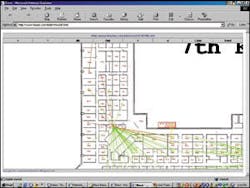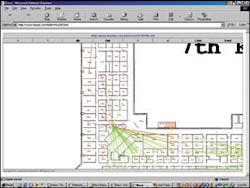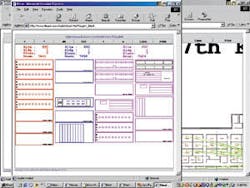Software technology can speed OSP and network projects, plus save money for installers and users.
Telecommunications project management is perhaps more challenging than in many other fields, due to unique technological complexities. At the same time, many key factors center on just knowing the basics of where your cabling installation's "assets" are located in the first place. Until recently, however, even that seemingly straightforward task was complicated and time-consuming.
With the power of software to revolutionize how vital information is quickly located and shared, it was inevitable that software would change telecommunications project management. Through proprietary software, Dimensionalized Asset Management Mapping (DAMM) can streamline project completion, saving companies millions of dollars in the process.
In addition, DAMM technology makes a significant difference in telecommunications installation and maintenance by:
- Showing whether companies are meeting Service Level Agreements (SLAs), through an audit trail built in on the backside of the system;
- Tracking bandwidth availability;
- Protecting against downtime in maintaining networks and showing where spare parts and people are located, as well as the closest repair vehicle.
DAMM's focus
Since asset maps are not new, what exactly is dimensionalized asset mapping?
This mapping service converts fiber/copper schematic diagrams and outside-plant (OSP) inventory into geocoded, hyperlinked assets as map layers. With its features in play, DAMM allows complex project tracking and lets network managers analyze, review and generate Web-based summaries in tabular and graphical form.
Essentially, DAMM pulls together several different technologies for map-based connectivity; these include Web, information, mapping and graphical interface systems. These asset maps indicate the location of all telco-related assets, such as handholes or manholes in the customer-owned OSP. The key is spotting these assets onto land-based maps, which, in turn, are hyperlinked for Web use.
With the development of a Web-based infrastructure, you can access the maps online on an as-needed basis. Unlike standard schematic diagrams, these maps are boldly color-coded so that anyone viewing them on an intranet can quickly and clearly see the precise location of, for example, all OSP fiber optics.
Project management
Typically, project management for telecommunications projects encompasses securing the right-of-way, engineering/design, planning, construction, and provisioning, with each having a percentage weight of how critical it is to the project as a whole. For example, securing right-of-way is 5% and construction is on the high side at 60%.
With DAMM, project managers using Web-viewable maps can see the progress of work (i.e., not yet begun, just underway, or partially completed) by looking at color-coded designations. Red may show work not begun, yellow for underway and green may indicate that the work is completed in the right-of-way and construction phases.
Also on these maps, personnel with intranet-viewing access may see specific buildings available for cable runs, the best route to run the cable, and whether buying or leasing is the best option. That same map can show construction in the underground where, for example, there are fiber and outside plant remote terminals.
DAMMs are also helpful in records research. Normally, locating records may consume almost three-fourths of a project engineer's worktime, in terms of determining assets and availabilities. With DAMM, these asset maps dramatically reduce the research time; managers simply click inventory assets and make instant scan copies.
Project reports are similar. A weekly project report using DAMM, for example, can show the project manager a complete report onscreen, making it unnecessary for him or anyone else to physically compile the information.
Who sees all these asset mapping features? That's up to you, and you can base your access criteria on such areas as password security levels or as determined by the project operations manager. For example, you might give a company president complete, unrestricted Web-based viewing, while the vice president of marketing may only see maps relative to marketing (such as a map of the infrastructure showing where the service can be sold). And real estate personnel may only be allowed to see the real estate-the location, how much the company owns, etc., but not the value.
These different security/viewing levels may be logically assigned because the electronic, color-coded maps contain as many as 40 layers. Each layer can be turned on or off, depending on viewer access.
DAMM streamlines the project management process with Web-viewable summaries for planning and scheduling manpower, tracking and evaluating subcontractor participation, tracking and modifying budgets, generating status reports for management, providing business intelligence for management decisions, and correlating project components to the work environment to maximize return-on-investment.
Other significant mapping applications
In addition to streamlining project efficiencies and such tasks as records research and report generation, DAMMs address other key issues on telecommunications projects. One occurs when broadband carriers do not own an entire network from source to user, resulting in numerous "last-mile" issues on both sides.
With this technology, you can track bandwidth availability and any degradation, such as equipment failures, via a database. For example, if a problem occurs with terminal equipment and the carrier states that it does not own the equipment (although it actually does), the mapping system can verify ownership through an audit trail.
This service-level audit will also show whether the company met the service-level agreement requirements or if any last-mile issues need to be addressed. Such issues may include whether a local loop problem exists or if there are poor amplifiers in the building's terminal equipment, for instance. In other words, the value is in maintaining networks and protecting against downtime by knowing where assets are located.
Case in point: a well-known telecommunications company had a loop cut but did not know "where the loop came and went." As a result, that loop cut shut off a major data center's access to the telecommunication company's equipment. The telco company outsourced finding of the loop through DAMM technology. Personnel located all the necessary information from their records, alphanumeric, tables, and legacy databases. Then they developed a DAMM to show the fiber ring. Had DAMMs been employed in the first place, the problem could have been repaired in only three hours as opposed to three weeks required otherwise.
DAMMs can also pinpoint locations of spare parts. By pointing and clicking the color-coded maps, for example, users can see where assets are deployed, how they are performing, which ones need replacement, and which ones just require maintenance.
From a dispatching perspective, if a company has a remote terminal 50 miles away, maintenance personnel may be located within that general reference area but equipment may be in an entirely different location. What is the most effective way to handle a maintenance problem with that remote terminal?
With DAMM, you can download GPS locators to a database that is updated on a minute-by-minute basis, referenced, and geocoded. Using dimensionalized asset maps, if someone wants to show the location of the nearest repair truck, the DAMM will spot it on the map. Click, and the screen shows who it is, then calls to send the repair truck to resolve the problem.
Here's a specific example. A telecommunications company thought it had a complete ring around a large metropolitan area. But the ring had two large "holes," of which the company was not aware because it had recently changed personnel twice and the company did not practice good record-keeping.
Based on the company's schematic drawings, however, DAMM spotted assets on a color-coding basis so that company personnel could see what was missing as well as what existed. It provided a virtual road map as to what was required to make the loop work, and the resources required to maintain the network.
Enhancing the infrastructure
Telecommunications project management is rarely short on challenges. But, adding leading-edge technology can make an important difference in allocating resources and people, as well as effectively managing major capital budgets. From right-of-way issues to last-mile considerations, dimensionalized asset management mapping is changing the way telecommunications professionals approach and execute telco projects.
Dimensionalized asset mapping is not an esoteric technology. To the contrary, it is based on "re-inventing" schematics of telecommunications assets that engineers have used for decades. The difference is spotting these onto CAD-generated, color-coded maps that anyone can readily view on the Web and clearly understand.
null
How the technology works
With DAMM technology, mapping includes creation, source conversion, query design, spatial analysis and graphical information system (GIS) interpretation by a well-trained staff (but no programmers required) using state-of-the-art equipment. DAMM includes translations to and from other standards, such as GIS and ortho-photography for land-based maps with digital imagery.
For example, as a management tool, asset mapping lets management administer multiple wire centers graphically. It eliminates needing manual maps for business planning, greatly reduces labor-intensive information collection, simplifies retrieval of LATIS (Loop Activity Tracking Information System) tracking unit details, FAP (Facility Analysis Plan) data cost, and posting wire center land-base maps into CAD maps.
As a management tool, DAMM technology lets you post color-coded current, proposed and CSTA (Cable Serving Terminal Address) project data on the map. Working through a typical asset mapping search, layered vectoring lets users drill down to capital assets regardless of their location or in what form the information is stored. From a wide view of a geographical area, you can go to the second layer, which shows streets and boundary from a legacy database. In the third layer, a click of the mouse reveals a map with all street names in vector format.
From the third layer, you can drill down to view each individual asset, such as the remote terminal configuration. Likewise, you can drill down to spreadsheet data where you can track high-cost areas, using a different color for each economic range. You can also generate numerous reports, such as a Penalty Report with various expense breakdowns. The mapping technology can store and recall any data format.
Adding other visual components makes asset mapping even more useful. With a low-cost digital camera and the Internet, for example, the asset database can easily be updated with scene photographs hyperlinked to map detail, and recalled with a mouse click.
Any of these components can be easily customized for a specific application.
Robert S. Limbaugh is president of Automated Information Management (AIM) in Houston, TX (www.tbaaim.com), a company providing engineering, mapping and information technology services to the telecommunications industry.



